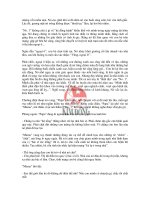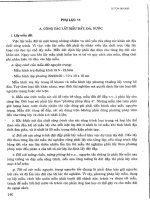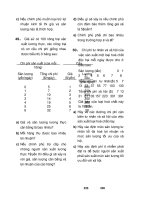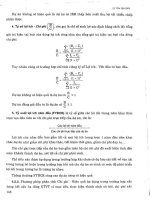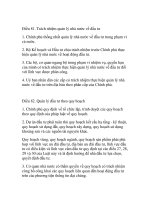May i have your attention please phần 10 doc
Bạn đang xem bản rút gọn của tài liệu. Xem và tải ngay bản đầy đủ của tài liệu tại đây (134.22 KB, 16 trang )
always in relation to others. It is in the fullness of self-love that we
have the capacity to love and care for others.
The issue as explained in this book is not our desire for atten-
tion. It’s how we meet that desire for attention and who we trust to
fill it. If you try to get from the attention something that it cannot
give, then you will warp that desire for attention.
In other words, if we think that the attention in itself will make
us feel whole, we will never get enough. The attention in itself will
never make us successful or worthy or triumphant. No amount of at-
tention can give those things. And if we think it will, then we will act
out in our business and personal life to get more and more attention.
We’ll end up doing all kinds of crazy things to raise the level of aware-
ness, kick it up a notch, keep people interested. Our actions will turn
into shocking and extreme measures to feed the attention-getting
monster. Our desire for attention becomes warped and often takes the
form of addiction. We get addicted to all kinds of things in business.
We get addicted to praise and we work ridiculous hours. We get ad-
dicted to power and we rant and rave to show others who is in
charge. We get addicted to money and we put our business through
its steps for all the wrong reasons, getting all the wrong results.
Attention is a good thing when you get it from trusted sources to
use for trustworthy reasons. Don’t try to get out of it what it can
never give. It cannot make you or your business whole. Only by
knowing who you really are will you know how to make yourself and
your business best known.
What will give you the energy and endurance to keep searching
for your true self? Every day you change and create more true stories
to live by and to base your true brand identity on. Everyday you must
ask what is true today. The thing that will give you the energy to keep
searching and digging will be hope.
Why do we hope? As long as we have hope we will have a long-
ing inside of us. Hope and aching go hand in hand. We hope for
something because we feel like we are missing something. And it is
that state of feeling like something is missing that makes us long for
something more. Hope makes us believe that all things are possible.
We don’t actually live in the state of knowing. We live in the land of
believing. Certainty flickers like a firefly’s light. Believing is an admis-
sion of hope. Sometimes hope is a state between doubting the least
and believing the most.
Conclusion—Back to You 207
ccc_hilicki_ch10_196-210.qxd 11/22/04 11:24 AM Page 207
Hope. It is hope that propels us. It is hope that compels us to
keep digging. When you keep digging you will ultimately discover
what is true. And the best thing will happen: You will behold who
you are and you will become what you see. This kind of hope does
not disappoint. If you hope to merely be like someone else you will
eventually be disappointed. It may motivate you for a while, but only
the hope we have in ourselves and the creator who made us for our
true purpose will satisfy us.
Our desperate desire to have our identity, our image, and our
brand make a difference now must be put into the context of how it
will make a difference always. If we only think of our brand identities
as an immediate source of power, then we are bad examples. Many
times I have worked with people who say they want a long-term, en-
during brand power. But when push comes to shove and crazy, busy
schedules force us into positions requiring immediate gratification,
we live and work for the day. Long-term strategies go out the window.
We end up with nothing more than new packaging, professional or
personal. As such, we are bad examples. We must live and work for
the future as much as we do for the day.
Hope makes us aware of our dissatisfaction. If we are satisfied
than we will not improve. If we are satisfied then our future is empty
because we are content with today’s prosperity or accomplishments.
It is the poor or desperate that we marvel at. They seem to leap up out
of nowhere, passing us by with unexpected success. They are not sat-
isfied. They hope for more. Too much success limits our hope. It cov-
ers up our greater need. Our riches blind us to what we need to be
doing. Our desire for more product or packaging, another clever ad
campaign, or instant web site messaging is only a fraction of our
long-term existence and influence. Hold on and hope for the future.
In the 2002 Hollywood movie Legally Blonde, Reese Witherspoon
plays Elle Wood, a Beverly Hills sorority princess turned serious Har-
vard law student. She voices our fears and frustrations of building our
true brand on our true story. About to give up, feeling betrayed and
abandoned by her friends and professors, she cries to the one person
who believes in her, “I’m tired of panty hose and business suits. I’m
going home to L.A. I’m tired of trying to be something that I’m not!”
Emmett, her hero and the associate law professor, responds: “What if
you’re trying to be something that you are?”
It is hard to be who you really are. Being you isn’t easy. It takes
even more strength and determination than pretending to be some-
208 MAY I HAVE YOUR ATTENTION, PLEASE?
ccc_hilicki_ch10_196-210.qxd 11/22/04 11:24 AM Page 208
one else. It may cause ridicule. It may be awkward. Fitting in can be
easier. Elle was a little bit fashion model and a little bit brain. In her
Los Angeles sorority she denied her brains, while at Harvard Law
School she denied her natural beauty and joy. It wasn’t until she com-
bined her brains and beauty into a complete package that she truly
represented her whole self and created her true brand identity—which
just happened to be incredibly successful. Lucky? No. Coincidence?
No. The result of building a brand based on true stories? Exactly.
Brands can awaken us to the grand fact that humans are capable
of much more than concrete service and productivity. Brands remind
us of our promise to bring each other beauty and equality, courage,
freedom, greatness, and human rights.
Go be your best brand and get the attention you’re worthy of.
Get the attention you need, in order to give back to everyone you
come in contact with the attention they deserve. Your brand occupies
the most important real estate that exists: the mind. Mind your busi-
ness and it will build your business, whether it is professional or per-
sonal, for success of every kind.
Be Yourself and You Will Be the Best Brand
If you’ve never come to the point of being yourself, come now. No
one else can label you good or bad. There’s just you. There’s no com-
plicated pathway to follow. There’s just the commitment to make to
be you. Be thankful for you, now. The more grateful you are for you,
the brighter you’ll shine. The brighter your light shines inside, the
farther it can be seen.
This branding process works on the principle that each of us,
and our corresponding brand identity, is complete and whole. Know
that this wholeness already exists inside of you. Give your brand
time to be.
Conclusion—Back to You 209
Brand Building Belief X
My brand already exists inside of me and my business. I will dis-
cover it, define it, and share it for the kind of success I need and
want.
ccc_hilicki_ch10_196-210.qxd 11/22/04 11:24 AM Page 209
210 MAY I HAVE YOUR ATTENTION, PLEASE?
The Final Big 10 Brand Builders
1. Recognize that you already have a brand whether you know
it or not. It’s time to take control of it to build an authentic
powerful brand destined for great success.
2. Identify and examine your own story, experiences, and life-
changing moments in your personal and professional life.
3. Attach importance to your story because it is real, unique,
and the only thing that can’t be copied.
4. Connect your experiences to the things that are important
to you—your values and beliefs.
5. Express these values as your brand values with correspond-
ing elements that are visual and audial, as well as those
characteristics that can be felt and make people feel.
6. Share these values in a way that incorporates as many of the
human senses as possible.
7. Communicate these brand values so that they relate to your
audience and can be easily remembered.
8. Reveal your authentic brand in a way that involves your au-
dience, listens, responds, and maneuvers as you anticipate
your audience’s changing needs and wants.
9. Write down a specific plan for your brand development and
the results you will achieve.
10. In the fullness of believing you are worthy and valuable,
turn the attention your brand receives back to the world to
meet and exceed their wants, needs, hopes, and dreams.
ccc_hilicki_ch10_196-210.qxd 11/22/04 11:24 AM Page 210
Notes
M
y sources for the ideas, stories, and quotes have been many
and have come from a wide variety of people and places: ra-
dio talk shows, television, music, books, newspapers, films,
magazine articles, Broadway plays, and conversations with friends
and colleagues.
In my research I have tried to be as complete and accurate
as possible. Any omissions of credit are entirely my own and are
unintentional.
CHAPTER 1 Everyone Needs a Little Attention,
Brands Need a Lot
1. Dr. Norman Vincent Peale, The Power of Positive Thinking, Random
House, Prentice Hall, 1952.
2. Interview with Stan Mitchell, preacher, minister, national speaker, au-
thor, Nashville, Tennessee, August 2004, gracepoint.com.
3. NBC, Channel 4 Special Feature Report on Chris Hilicki by anchor-
woman and reporter Terry Merryman, September 2003.
4. Bill Cosby, American comedian, author, movie star, television personal-
ity, and philanthropist. Brainyquote.com.
211
ccc_hilicki_notes_211-216.qxd 11/22/04 11:26 AM Page 211
CHAPTER 2 True Confession: Good for the Soul, Great for the Brand
1. Henry David Thoreau, American essayist, poet, and philosopher,
renowned for living the doctrines of Transcendentalism as recorded in
his masterwork, Walden. QuoteDB.com.
2. Inc. magazine, January 2003.
3. Coca-Cola.com.
4. Dotson Rader, “My Goals Have Changed,” Parade magazine, November
30, 2003.
5. Jill Lawrence, “Candidates Draw from the Painful and the Private,” USA
Today, December 3, 2003.
6. Eleanor Roosevelt became First Lady in 1933. www.whitehouse.gov
/firstladys.
7. Rudyard Kipling, born in Bombay, India, English short-story writer, nov-
elist, and poet. Quoteland.com.
8. Suzanne Vranica and Brian Steinberg, “McDonald’s Seeks Spicier
Tagline,” Wall Street Journal, June 12, 2003.
9. Kevin Dunn, president, Dunn Enterprises, former U.S. president of Mc-
Donald’s, interviewed summer 2003 and August 2004.
10. Maya Angelou, internationally respected poet, writer, and educator.
QuoteDB.com.
CHAPTER 3 Brand-Stand: Your Platform for Success
1. Brainyquote.com.
2. Southwest Airlines Spirit, August 2003, ORC International.
3. “Melissa Etheridge, Just Jeans and a T-Shirt, Thank You,” Self, June
2003.
4. Conversation with Stephen Schutz, coowner, Blue Mountain Arts greet-
ing card company and bluemountain.com, June 4, 2004, Chicago, Illi-
nois, Book Expo Association trade show.
5. Larry King Live, guest Pamela Peele, May 4, 2003.
6. Brainyquote.com.
CHAPTER 4 Bring On the Brand
1. Walt Disney, Disney.com.
2. Lyriks.com, Janis Ian, pop singer and performer.
3. Neal E. Boudette, “BMW’s CEO Just Says ‘No’ to Protect Brand,” Wall
Street Journal, November 26, 2003.
4. Brainyquote.com.
5. Joan Duncan Oliver, “Kindness: The Ripple Effect,” O magazine, Decem-
ber 2002.
212 NOTES
ccc_hilicki_notes_211-216.qxd 11/22/04 11:26 AM Page 212
6. “Home Depot Bernie Marcus,” Southwest Airlines Spirit, August 2003.
7. Interview with Julia Burney, founder, Cops ’N’ Kids, October 2003, Mary-
land literacy campaign with Cops ’N’ Kids.
8. Interview with “Van” Cronkhite, February 2004, Milwaukee, Wisconsin.
CHAPTER 5 Making a Brand Impression
1. Ralph Waldo Emerson, American poet, philosopher, and center of the
American transcendental movement. Brainyquote.com.
2. Anthony Robbins, authority on peak performance, motivation, and
the creator of Personal Power. Unleash the Power Within conference,
March 2003.
3. Inc. magazine, interview with Barbara Corcoran, January 2003.
4. Tim McGraw, multi-platinum recording artist, “She’s My Kind of Rain,”
Lyriks.com.
5. Greatquotations.com.
6. Marc Gobé, Emotional Branding, Allworth Press, 2001, from the Introduc-
tion, page xxiv.
7. Jeff Resnick, “Does Your Brand Walk the Walk?” in Marketing Review,
1966. Marketingprofs.com.
8. “US Teens Take Hard Line,” USA Today, Spring 2003.
9. Bruce Orwall, “Wishing upon a Logo,” Wall Street Journal, February 28,
2003.
CHAPTER 6 Brand Relativity
1. Anaïs Nin, The Diary of Anaïs Nin (Harcourt Brace).
2. “The New Establishment 2002,” Vanity Fair, October 2002.
3. CMAWorld.com. 2002 MRI country listener analysis, 2002 analysis high-
lights.
4. Televised CMT biography of Garth Brooks, Inside Fame, 2003.
5. “Melissa Etheridge, Just Jeans and a T-Shirt, Thank You,” Self, June 2003.
6. Research International Observer (RIO), “Branding: The Third Wave Is
Here,” 2003.
7. Bruce Orwall, “Wishing upon a Logo,” Wall Street Journal, February 28,
2003.
8. Lorry Grant, “Retailers Try New Venues to Boost Sales,” USA Today, May
13, 2003.
9. Bernard Condon, “Banking on Brashness,” Forbes, August 16, 2004.
10. Peter Montoya and Tim Vandehey, The Brand Called You, ©2004.
11. Effective Seminar/Conference Marketing, Ralph D. Elliot, PhD, vice Provost
for Off-Campus Distance and Continuing Education, Clemson University,
South Carolina, />Notes 213
ccc_hilicki_notes_211-216.qxd 11/22/04 11:26 AM Page 213
CHAPTER 7 Planning for Your Brand
1. QuoteDB.com and ThomasEdison.com.
2. Interview with Tim Sheehy, president of Milwaukee Metropolitan Asso-
ciation of Commerce, Fox Point, Wisconsin, March 2004.
3. Interview with Phil Vischer, creator and founder of VeggieTales, July
2004.
4. C. S. Lewis, The Inspirational Writings of C. S. Lewis, Inspirational Press,
1987.
CHAPTER 8 Getting Results from Your Brand
1. BrainyQuote.com.
2. Interview with “Van”Cronkhite, author, in Milwaukee, Wisconsin, Febru-
ary 2004.
3. Interview with Pete Fisher, businessman, brand expert, and general man-
ager of the Grand Ole Opry, spring of 2003.
4. Brian Tracy, Victory! Applying the Proven Principles of Military Strategy to
Achieve Greater Success in Your Business and Personal Life.
5. Liz Murray Garrigan, “800-Pound Gorilla Rattles the Cage,” City Limits,
February 20, 2003.
6. Charles Darwin, Darwin.com.
7. Michael Meyer, “Recipe for Success,” USA Weekend, July 18–20, 2003.
8. QuoteDB.com and ThomasEdison.com.
9. Brainyquotes.com.
CHAPTER 9 Sustaining the Results You Get from Your Brand
1. QuoteDB.com.
2. www.itsjustlunch.com, Southwest Airlines Spirit, August 2003.
3. Quoteland.com.
4. John Bloom, UPI, National Review Online, Forbes, March 31, 2003.
5. Robert S. Greenberger, “Victoria’s Secret Loses Court Case on Use of
Name,” Wall Street Journal, March 6, 2003.
6. Ibid.
CHAPTER 10 Conclusion—Back to You
1. Norman Vincent Peale, The Power of Positive Thinking, Random House,
Prentice Hall, 1952.
2. BrainyQuote.com.
214 NOTES
ccc_hilicki_notes_211-216.qxd 11/22/04 11:26 AM Page 214
3. “LeAnn Rhymes, Standing Up to the Spotlight,” Self, June 2003.
4. Rudyard Kipling speech, February 14, 1923.
5. Quoteland.com.
6. Brainyquote.com.
Internet Reference Sources
Notes 215
anthonyrobbins.com
baseball-almanac.com
buildingbrands.com
cmaworld.com
crosswalk.com
dga.com
fastcompany.com
forbes.com
fsb.com
grokdotcom
hbsp.harvard.edu
history.org
inc.com
itsjustlunch.com
justdisney.com
MarketingProfs.com
opinionresearch.com
Petermontoya.com
scottjeffrey.com
self.com
sethgodin.com
wizardacademy.com
ccc_hilicki_notes_211-216.qxd 11/22/04 11:26 AM Page 215
ccc_hilicki_notes_211-216.qxd 11/22/04 11:26 AM Page 216
Index
Abercrombie & Fitch, 48
Accomplishments, 88–89
Accounting fraud, 176
Actions, significance of, 108–112
Advertisements, impact of, 93–94
Advertising strategies, 142–144
Alignment, 125–128
Anderson, Harold, 38
Appreciation, 80
Artistic company, 166–167
Attention:
customer service and, 185–187,
189–190
humility and, 15–19
importance of, 14–15, 185
relationship with brands, 3–4
strategies for, see Attention
strategies
Attention strategies:
accomplishments, 88–90
branding up, 93–96, 102
brand pressure, 99–102
community service, 96–99
competition, 90–92
confidence, 83, 102
constancy, 83, 102
courage, 83, 102
curiosity, 83, 102
emotions/emotional response,
86–88, 92
listening, 84–86
Audience, connection with, 39, 72,
75–76, 92–95, 107–108
Authentic brands, 6
Authenticity, importance of, 20, 43,
52–54, 63–64, 73, 89, 98, 109–110
Bashford, Martha, 73–74
Belief system, 53, 58, 67–68, 94,
183
Best-known brands, components of,
174
Betty Crocker, 172–173
Blue Mountain
Arts/bluemountain.com,
68
BMW, 89
Bonding, 188–189
Boot Straps, 95
Boston Market, 167
Brainstorming, 133
Brand(s), generally:
attention and, 3–4
as competitive factor, 37–39
concrete, bankable value, 25
development of, 6, 8–9, 36–37,
86–87, 169–171
need for, 28–30
significance of, 23–27, 33–34
types of, 6
Brand awareness, 86, 175
Brand backlash, 48
Brand bashing, 187–188
Brand billboards, 133–137
Brand boxes, 166–168
Brand Builders, Final Big 10, 210
Brand Building Beliefs, 21, 55, 81, 102,
119, 144, 158, 180, 195, 209
217
ccc_hilicki_ind_217-221.qxd 11/22/04 11:28 AM Page 217
Brand conversion, 112–115
Brand disconnect, 182
Brand equity, 188
Brand identity, discovery of,
198–199
Brand impression, development of:
actions, 108–112
brand conversion, 112–115
customer loyalty, 116–118
elevator speech, 115–116
emotional connection, 110–111
emotional experimentation,
105–106
secrets, 106–107
Branding, generally:
defined, 5–6, 47
historical perspective, 7
storytelling and, 11–14
trend in, 49
Branding cycle, 79–80
Branding up, 93–96, 102
Brand integrity, 89, 201–202
Brand language, 203–204
Brand management, 169–170
Brand maps:
brand boxes, 166–168
labels, 165–166
purpose of, 160–163
Brand maturity, 199–201
Brand pressure, 99–102
Brand protection, 192–194
Brand reconciliation, 88–90
Brand relativity:
advertising, 142–144
alignment, 125–128
creativity, 128–132
evaluation of, 120–125
misfits, 128
publicity, 142–144
theme song, 140–142
truth and, 132
visibility, 128–140
Brand saturation, 97
Brand travel, 163–165
Brand worth, 204–205
Brooks, Garth, 122–123
Burney, Julia, 98–99
Business ethics, 117–118, 176
Business relationships, 83
Calvin Klein, 48, 175
Celebrities, 61–65
CEO behavior, impact of, 174–175
Change, response to, 168, 172–173,
191–192, 204–206
Chaos, impact of, 164
Character, sources of, 94
Charisma, 114–115
Cheney, Dick, 26
Clinton, Hillary, 151
Coca-Cola, 25, 92, 191
Color research, 143–144
Communication skills:
brand language, 203–204
listening, 84–85
storytelling, 76–77, 100, 149–150,
201–202
two-way communication, 85,
202
Community company, 167
Community service, 96
Compassion, 75, 205
Competition, 13–15, 37–39, 57, 64–65,
87, 90–92, 97
Competitive edge, 196–198
Confidence, 83, 102, 109
Conformity, 64–65, 167
Constancy, 83, 102
Consumer behavior:
expectations, 88, 96
loyalty, see Customer loyalty
motivation, 63
product selection factors, 57–58
wants, needs, and desires, 94, 96
Cops ’n’ Kids, 98
Copycat-brands, 149, 177
Copyrights, 192–193
Corcoran, Barbara, 110–111
Core identity, 59, 172
Corporate company, 167
Corporate image, 7
Cosby, Bill, 40–41, 62, 109
Courage, 83, 102
Creativity, 128–132
Credibility, 190
Crises, impact of, 166
Criticism, impact of, 66, 91–92
Curiosity, 83, 102
Customer contact, 185–186, 200
218 INDEX
ccc_hilicki_ind_217-221.qxd 11/22/04 11:28 AM Page 218
Customer loyalty, 9, 31, 44, 49–50,
116–118, 123–124
Customer service, 185–187, 189–190
Dalmatian Press, 18, 31, 37–41, 60, 62,
67, 85–87, 129–131, 133, 137,
153–154, 164–165, 176–177, 191,
200
Designer brands, 59–60
Destructive behavior, 15
Direct marketing companies, 124
Disney, Walt, 82–83
Dole, Elizabeth, 151
Dreamworks, 8, 137–138, 167
Dunn, Kevin E., 44
Ego, impact of, 151
Elevator speech, 115–116
Emotion, impact of, 43, 45. See also
Emotional response
Emotional connection, 110–111
Emotional dialogue, 203
Emotional experimentation, 105–106
Emotional response, 48, 92, 93–96
Empathy, 72, 75–76, 205
Entrepreneurial company, 167–168
-Est brand, 174–176
Etheridge, Melissa, 123
Evangelists, 113–114, 116
Exploitation, 39–41
Failure:
dealing with, 132
recognition of, 182–183
Fairstein, Linda, 73–75
False beliefs, 84
Family-owned businesses, 167
Faux branding, 49–52
Fear, dealing with, 203
Features, as competitive factor,
37–38
Federal institutions, 167
Feedback loop, 80
Fein, Benjamin, 74–75
Firestone, 175
First impressions, 30–32
Fisher, Pete, 169–170
Focus, importance of, 171–172
Franchises, 124
Gap, 129
Gates, Bill, 74
General Electric, 175
Generic brands, 60
Gifford, Kathie Lee, 175
Giuliani, Rudy, 109
Global brands, 45, 125
Goal-setting, 35, 150–154
Goldford, Dennis, 26
Grand Ole Opry, 169–171
Haidt, Jonathan, 92
Hallmark, 25, 93
Handwritten notes, 187
Hanks, Tom, 121
Harpo Productions, 168. See also
Winfrey, Oprah
Hazen, Cindy, 53
Healing company, 167
Home Depot, 96
Hope, 206–209
Humility, 15–19, 176
Humor, 53–54
Identity:
distinguishing characteristics of,
183–184
significance of, 9–11
Image protection, 88
Imagination, 173–174
Imitation brands, 60–61, 149, 177
Informational company, 166
Institutional company, 167
Intentions, significance of,
175–176
Intimacy, 92
Johnson, Sam, 186
Johnson Control, 166
Johnson Wax, 166, 186
Jordan, Michael, 63–64
Kentucky Fried Chicken, 139, 154
Kovacevich, Richard, 129
Labels, impact of, 30, 51–52, 165–166,
209
Lasting impressions, 32–33
Life experience, see Personal history
Index 219
ccc_hilicki_ind_217-221.qxd 11/22/04 11:28 AM Page 219
Limbaugh, Rush, 174
Lindner, Rich, 113
Listening, importance of, 84–85
Loews Cineplex, 127
Logos, 7, 47, 98, 134, 149, 152–154
Lowe’s, 127
Loyalty, see Customer loyalty
McDonald’s, 29, 43–45, 128
Macy’s, 127–128
Madonna, 58–59, 154–155
M&M’s, 43, 45
Maneuverability, 172–173
Map markers, 160–163. See also Brand
maps
Marcus, Bernie, 96
Marketing, 47
MasterCard, 32
Media, impact of, 84, 99
Memories, 77–79, 156–158
Microsoft, 130
Midwest Airlines, 155
Mistrust, 48
Modeling, 52
Moral beauty, 92
Music, role in branding, 44,
140–142
Names/naming:
selection process, 69–70
significance of, 58–60, 194
Networking, 73
New brands, 97
Nonprofit company, 167
Nurturing behavior, 53
Objectives, importance of, 170–172
Off-brand, 61
Once-upon-a-time treasures, 66
On-site visits, 186
O’Reilly, Bill, 175
Organizational analysis, 148
Organizational value, 64
Originality, 27–29
Owens, Ginny, 90–91
Packaging, 172
Painful treasures, 66, 68
Panke, Helmut, 89
Peele, Pamela, 71
Perfect treasures, 65–66
Personal appearance, 123–124
Personal brand identities:
authenticity, 63–64
in business, 60–61
conformance, 64–65
development of, 61
self-examination, 65–69
significance of, 56–57, 59
uniqueness of, 62–63
Personal history:
connection with, 157–158
impact of, 66–67, 70–72, 100
memories, 77–79, 156–158
significance of, 16–21, 36,
41–42
support system and, 71–76
Personality, 95–96
Personal values, 60
Planning strategies:
goal-setting, 150–154
mirror images, 154–158
storytelling, 149–150
true story, 146–149
Politicians, 26–27
Ponderosa, 47
Positive imagery, 138
Powerful brands, 191–192
Pricing strategies, 37–38, 44, 117
Pride, 15–16, 176
Prioritizing, 168
Product development, 197–198
Product selection, reasons for, 57–58
Professional brand identities, 56–57,
59
Profit, influential factors, 90
Publicity, 142–144, 175
Publix, 93
QSC&V (quality, service, cleanliness,
and value), 44–45
Referrals, 190
Relationship(s):
bonding, 188–189
development of, 187–188
Reputation, 30, 36, 57, 84, 87–88, 106,
126, 175
220 INDEX
ccc_hilicki_ind_217-221.qxd 11/22/04 11:28 AM Page 220
Result(s) tracking strategies, see Brand
maps
Retirement planning, 33
Revenues, influential factors, 90
Robbins, Tony, 107
Rolex, 125
Rules, perceptions of, 53–54
Sales, defined, 47
Sales calls, 200. See also On-site visits
Schutz, Stephen, 68
Schutz, Susan Polis, 68
Secrets, implications of, 106–107, 147,
164
Self-concept, 13
Self-esteem, 28
Self-examination, 65–69, 102, 154,
157, 164, 190, 198, 202
Self-improvement, 53, 83
Self-interest, 206–207
Selfishness, 206
Self-respect, 20, 28
Sensory impressions, 42–45
Sharing your story, 20–21
Slogans, 143, 149, 194
Spielberg, Steven, 8, 137–138
Starbucks, 126–127
Stern, Howard, 174
Stewart, Martha, 61, 74, 124
Storytelling:
benefits of, 100
components of, 76–77
integrity in, 201–202
skills development, 149–150
two-way communication, 85, 202
Strategic partnerships, 188
Strategic planning, 36
Strong, Dick, 125–126
Subjectivity, 95
Successful brands, components of,
176–180
Sundance, 167
Support system, 71–76
Taglines, 143. See also Slogans
Target, 179–180
Target audience, identification of, 30
Tennessee Bun Company, 135–136
Theme song, 140–142
Trademark laws, 192–193
Treasures:
identification of, 68–70
types of, 65–68
True-life experiences, 60
True story, significance of, 122–123,
146–149, 164, 198–199. See also
Authenticity; Uniqueness
Trust development, 88
Truth, as influential factor, 46–47
Two-way communication, 85, 202
Two-way relationships, 20
Tylenol, 175
Uniqueness, 39, 42, 52, 58, 61–62, 73,
95, 168, 191–192
Unique selling proposition (USP), 115
Value creation, 64
Values:
identification of, 148
reinforcement of, 126–127
Victoria’s Secret/Victor’s Little Secret,
193–194
Vischer, Phil, 157
Visibility:
advertising, 142–144
billboards, 133–137
importance of, 128–132
personal appearance and, 137–139
publicity, 142–144
theme songs, 139–142
Visionaries, 190
Visualization, 180
Wal-Mart, 37–38, 117, 167, 175, 179
Walt Disney Company, 30–31,
117–118, 128
Walters, Barbara, 151–152
Walton, Sam, 37, 100, 197
Warner Bros., 31, 85
Welch, Jack, 109
Well-being, influential factors, 86
Welu, Tim, 188
Western Publishing, 23, 67, 172–173
Winfrey, Oprah, 8, 41, 54, 61, 63, 98,
100, 109–110, 168
Zimpher, Nancy, 138–139
Index 221
ccc_hilicki_ind_217-221.qxd 11/22/04 11:28 AM Page 221
About the Author
222
C
hris Hilicki is an expert brand builder, founder of Dalmatian
Press (one of the nation’s largest children’s publishers), na-
tional speaker, television personality, world traveler, and self-
growth enthusiast, and author of May I Have Your Attention, Please?
As a scientist-turned-publisher she has helped to create patented
products and best-selling children’s titles. A survivor and conqueror of
several life-threatening diseases and events, she inspires and motivates
many people to persevere and succeed. Chris’ most important mission
is to affect lives so that people learn to like and love themselves, ulti-
mately becoming more valuable and successful in the world.
Find out more about Chris and how you can build a better fu-
ture at www.hilicki.com.
ccc_hilicki_ata_222.qxd 11/22/04 11:30 AM Page 222

